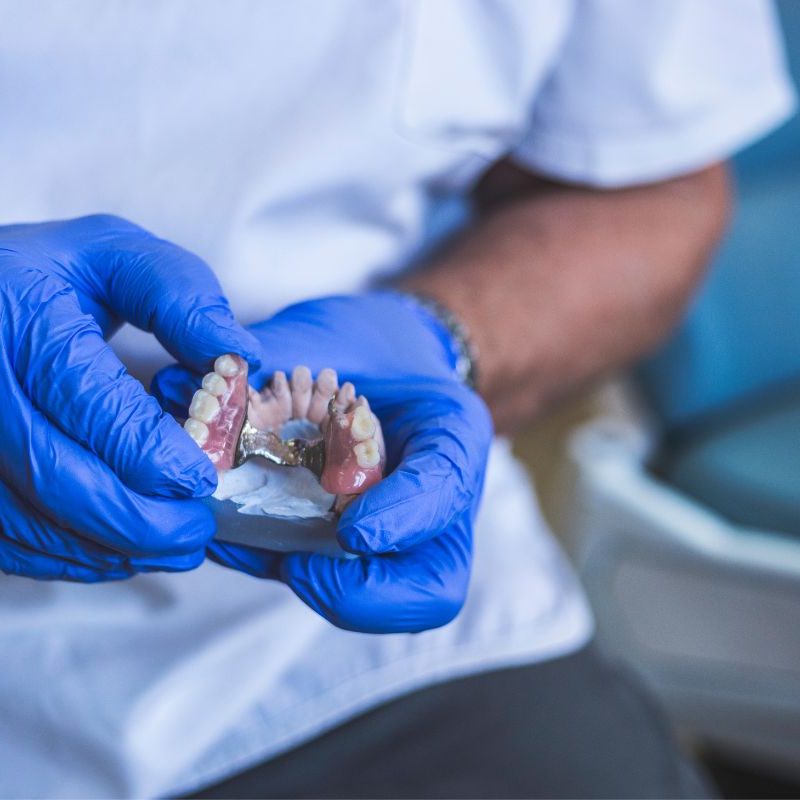What is Dental Dentures
Dental dentures may be partial and complete. In case if few teeth are missing, a partial denture is used, while in the case of full missing teeth, a complete denture is used. The method is applied for the betterment of teeth and increasing the chewing ability of an individual who has accidentally lost his teeth.
A denture is also removable. Two sorts of denture teeth are used – complete and halfway denture teeth. Complete denture teeth are utilized when all of the teeth are missing, while fractional denture teeth are utilized when some normal teeth remain.

Complete Dentures
Complete denture teeth can be “customary” or “quick.” Made after the teeth have been eliminated and the gum tissue has started to recuperate, a regular dental replacement is prepared for a position in the mouth around eight to 12 weeks after the teeth have been taken out.
In contrast to customary false teeth, prompt false teeth are made ahead of time and can be situated when the teeth are taken out. Thus, the wearer doesn’t need to be without teeth during the mending time frame. Be that as it may, bones and gums contract after some time, particularly during the recuperating time frame following tooth evacuation. Accordingly, a detriment of quick false teeth contrasted and regular false teeth are that they require more acclimations to fit appropriately during the mending system and by and large ought to just be viewed as a transitory arrangement until traditional false teeth can be made.
Fractional Dentures
A removable fractional dental replacement or extension generally comprises substitution teeth appended to a pink or gum-hued plastic base, which is once in a while associated with a metal structure that holds the dental replacement set up in the mouth. Incomplete false teeth are utilized when at least one regular teeth stay in the upper or lower jaw. A decent extension replaces at least one teeth by putting crowns on the teeth on one or the other side of the space and joining fake teeth to them. This “span” is then established in place. Not exclusively does a fractional dental replacement occupy the spaces made by missing teeth, it keeps different teeth from evolving position. An accurate incomplete dental replacement is removable and has inner connections rather than fastens that append to the contiguous crowns. This is a more regular looking machine.
Types of Denture Adhesives
There are different types of denture adhesives used for applying dentures. Two main types are discussed in the below paragraphs.
Glue application
Apply this dental replacement cement to a dry or ideally wet dental replacement. Try not to put cement near the dental replacement borders. If the glue overflows, utilize less of the item. For false teeth on the upper jaw, apply three short pieces of cement – or a progression of little specks – along the edge region and one down the middle. For false teeth on the lower jaw, apply three short segments of glue – or a progression of little specks – in the focal point of the edge region.
Powder application
Sprinkle a flimsy, uniform layer all through the tissue-bearing surface of the dental replacement. Shake off abundance powder and press the dental replacement into place. Powders might be liked over glues since they are simpler to clear off the dental replacement and tissue. What’s more, they don’t have a similar propensity as glues do to “shim” (get the dental replacement far from the tissue).
Precautions For PRotection
In order to keep your dentures protected, you need to protect them and take the following precautions.
- Flush your false teeth prior to cleaning to eliminate any free food or flotsam and jetsam.
- Utilize a delicate fibre toothbrush and a non-grating chemical to tenderly brush every one of the surfaces of the false teeth so they don’t get scratched.
- When brushing, clean your mouth completely—including your gums, cheeks, top of your mouth and tongue to eliminate any plaque. This can assist with lessening the danger of oral aggravation and awful breath.
- At the point when you’re not wearing your false teeth, put them in a protected spot shrouded in water to hold them back from distorting.
On the off chance that you have any inquiries concerning your false teeth, or on the other hand on the off chance that they quit fitting admirably or become harmed, contact your dental specialist. Make certain to plan ordinary dental exams, as well. The dental specialist will look at your mouth to check whether your false teeth keep on fitting appropriately.
